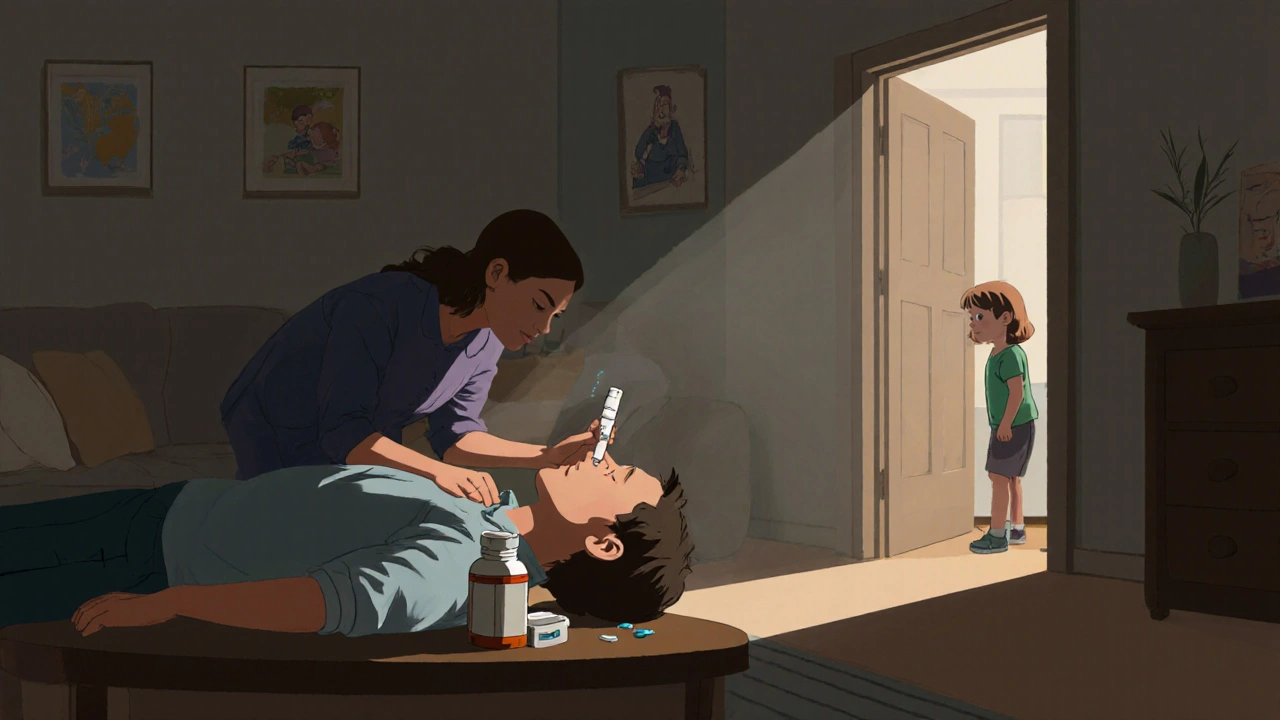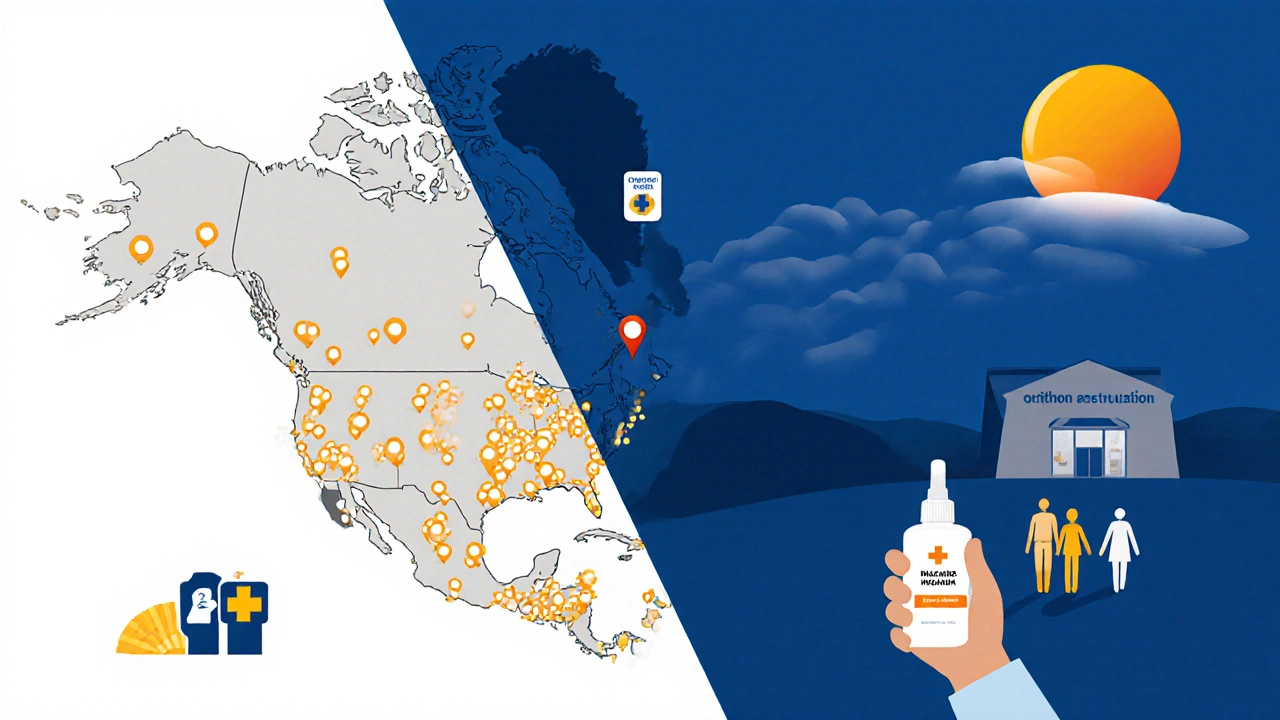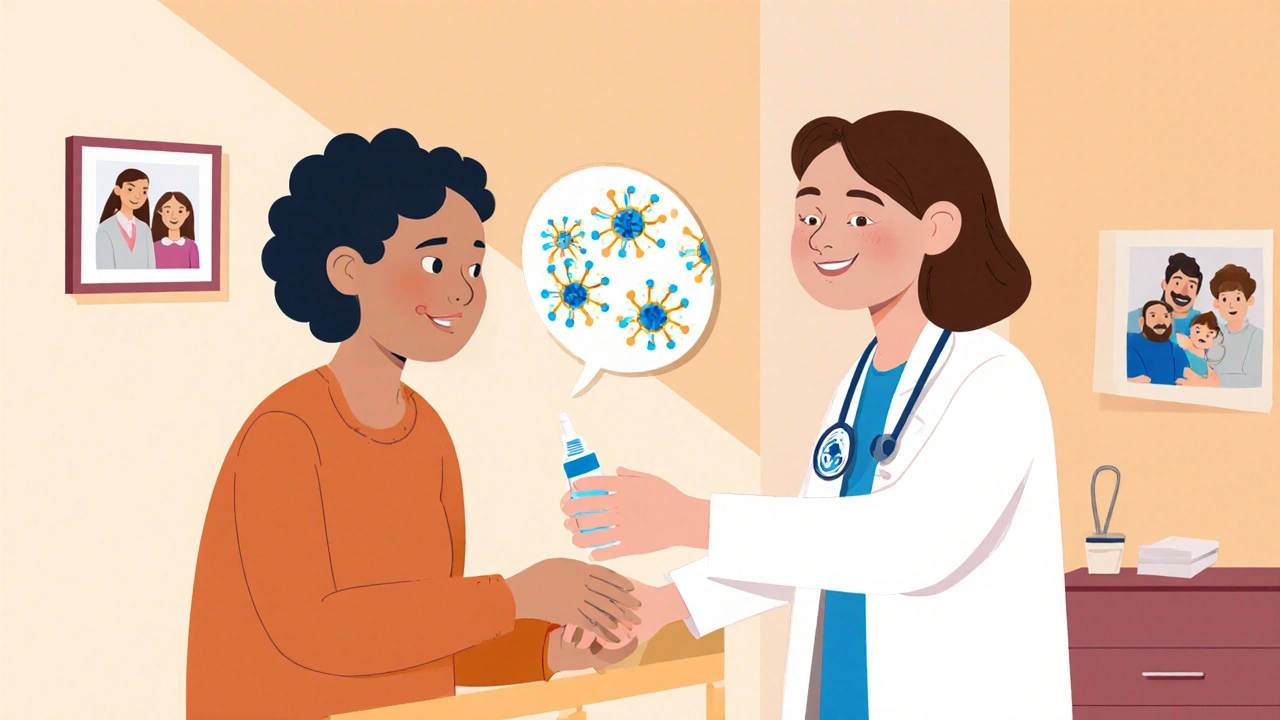Naloxone Risk Assessment Tool
This tool helps you understand your risk of opioid overdose based on CDC guidelines. It shows whether naloxone co-prescribing is recommended for your situation.
Your naloxone recommendation
When a doctor prescribes an opioid for chronic pain, they’re not just giving you a pill to manage discomfort. They’re also handing you a risk-especially if you’re on 50 morphine milligram equivalents (MME) or more per day. That’s the threshold where your chance of a fatal overdose doubles. But here’s the part most people don’t know: naloxone co-prescribing is now a standard part of that conversation. It’s not optional. It’s not extra. It’s life insurance written into your prescription.
What Naloxone Actually Does
Naloxone isn’t a cure for addiction. It doesn’t ease pain. It doesn’t make you feel better. It’s a simple, fast-acting drug that kicks opioids off your brain’s receptors. When someone overdoses, their breathing slows or stops. Naloxone reverses that-often in under two minutes. It’s like a reset button for the body’s breathing system. And it only works on opioids. If someone overdoses on cocaine or alcohol, naloxone does nothing. But if it’s fentanyl, oxycodone, heroin, or hydrocodone? It saves lives.
The most common form today is the nasal spray-Narcan® or generic versions. No needles. No training needed. You spray it in one nostril. That’s it. There’s also an injectable version, but most people, including family members and first responders, use the nasal spray. It’s stable at room temperature. Doesn’t expire quickly. And it’s been approved for over-the-counter sale in many places since 2023.
Who Gets Naloxone With Their Opioid Prescription?
The CDC says: if you’re on 50 MME or more per day, you should be offered naloxone. But that’s just the start. Other high-risk groups include:
- People taking benzodiazepines (like Xanax or Valium) with opioids
- Those with a history of substance use disorder
- Patients with COPD, sleep apnea, or other breathing problems
- Anyone who’s had a non-fatal overdose in the past year
- People recently released from jail or prison
- Those using alcohol heavily or using stimulants like meth or cocaine
Why? Because fentanyl is now mixed into almost every street drug. Even if you’re not using illicit opioids, your prescribed painkiller could be the one that kills you-especially if you’re on a high dose or mixing it with other depressants. And if you’ve been in jail, your tolerance drops fast. The first pill you take after release can be deadly.
How It Works in Real Life
Here’s what happens in a clinic that does this right. The doctor checks your prescription history using a state database (PDMP). They see you’re on 80 MME of oxycodone daily. They ask: “Have you ever felt like you couldn’t breathe when you took your meds?” “Do you ever sleep longer than normal after your dose?” “Has anyone in your house ever had a problem with drugs?”
If the answer is yes to any of these, they say: “I’m going to give you a nasal spray. It’s not because I think you’ll overdose. It’s because if someone else accidentally takes your pills-your kid, your grandparent, your roommate-this can bring them back. And it’s free or nearly free with insurance.”
They don’t hand it over and walk away. They show you how to use it. They tell you what to look for: blue lips, no response, slow breathing. They say: “If you’re not sure, spray it anyway. It won’t hurt someone who doesn’t need it.” Then they make sure the person who lives with you knows where it is and how to use it.

Why People Refuse-And How to Overcome It
One in two patients says no at first. Why? Shame. Fear. “Are you saying I’m going to die?” “Does this mean you think I’m an addict?”
But here’s what actually happens when people change their mind. Sarah Johnson, a 52-year-old from Ohio, was prescribed oxycodone for back pain. When her doctor offered naloxone, she cried. “I felt judged,” she told a support group. But when her 16-year-old son found her pills and took them by accident, she used the spray. He woke up in the ER. “That spray saved his life,” she says. “Now I carry it everywhere.”
Providers who use motivational interviewing-asking open questions, listening, not pushing-see refusal rates drop by half. The goal isn’t to scare people. It’s to empower them.
Cost, Access, and the Big Gaps
Generic naloxone nasal spray costs $25-$50 without insurance. Brand-name Narcan® is still $130-$150. But thanks to the SUPPORT Act of 2018, most insurance plans cover it with $0 copay. Medicare and Medicaid have to cover it. Pharmacies in cities usually have it in stock. In rural areas? Only 42% do. That’s a problem. If you live in a small town and your doctor prescribes it, you might have to drive 50 miles to get it.
And even when it’s available, only 38% of high-risk patients actually get it. Why? Doctors don’t bring it up. They’re uncomfortable. A 2021 study found 68% of primary care doctors avoid the topic because they fear upsetting patients. But when they do, outcomes improve dramatically. One clinic in Kentucky saw 17 overdoses reversed by family members after they started co-prescribing in 2021.
State Laws Are Changing Fast
Not all states are the same. In New York, any patient getting an opioid prescription must be offered naloxone. In California, it’s only required if you’re on 90 MME or more. In 24 states, it’s legally required. In others, it’s just a recommendation.
And pharmacists can now dispense naloxone without a prescription in 49 states. That means you don’t need to wait for your doctor. Walk into a pharmacy and ask. Most will give it to you on the spot.

What Happens When It’s Used
Studies show that when naloxone is co-prescribed, emergency room visits for opioid overdoses drop by 47%. Hospitalizations drop by 63%. That’s not just saving lives-it’s saving healthcare dollars.
And the effect isn’t small. For every 10% increase in naloxone distribution, opioid deaths drop by 1.2%. That’s not a guess. That’s data from the National Institute on Drug Abuse. When you put naloxone in the hands of people who live with opioid users, you create a safety net that works.
What’s Next
The FDA just approved the first generic nasal spray in 2023. Prices are falling. The NIH is funding research into a long-acting version that could last for days. And in 2024, the Biden administration allocated $500 million just for naloxone distribution.
But the biggest barrier isn’t cost or availability. It’s silence. Too many doctors still don’t bring it up. Too many patients still think it’s a sign they’re failing. They’re not. They’re being smart.
Having naloxone doesn’t mean you’re at risk of dying. It means you’re taking responsibility-for yourself and for the people who love you.
What to Do If You’re Prescribed Opioids
Don’t wait for your doctor to mention it. Ask:
- “Am I at risk for overdose?”
- “Should I have naloxone with this prescription?”
- “Can you show me how to use it?”
- “Can you give one to my spouse or parent too?”
- “If my pharmacy doesn’t have it, where can I get it?”
If you’re on opioids, keep naloxone in your medicine cabinet, your car, your purse. Don’t hide it. Don’t be embarrassed. The people who need it most are the ones who never think they’ll need it.
And if you’re a family member of someone on opioids? Learn how to use it. Keep it close. You might not know it, but you could be the reason they wake up tomorrow.

Iska Ede
So let me get this straight - we’re giving out life-saving spray like candy, but doctors still act like they’re handing out a death sentence? 😒 I’ve seen people cry because they were offered naloxone. Meanwhile, their kid’s on Adderall and their cousin’s on Percocet and no one bats an eye. Double standards are alive and well.
Gabriella Jayne Bosticco
I work in a rural ER. We’ve reversed 12 overdoses in the last 8 months - all with naloxone kits handed out by the clinic. One guy’s mom carried it in her purse like a spare key. She said, 'I don’t want to lose him over a pill.' Simple. Real. No drama.
Katelyn Sykes
I used to think naloxone was just for junkies until my cousin took his dad’s pain meds after a party and passed out. We had the spray because my aunt got it with her own script. Sprayed him in the ER parking lot before they even got the ambulance. He woke up confused but alive. That thing is a miracle. Everyone should have one. Period
Gabe Solack
I carry two in my truck now. One in the glovebox. One in my jacket. My sister’s on 120 MME. She didn’t want it at first. Said it made her feel like a walking target. Then she saw the stats. Now she hands them out to her friends like they’re gum. 🙌
Yash Nair
This is what happens when you let western guilt run the medical system. Why not just give everyone a parachute before they get in a car? We’re normalizing fear. People don’t need naloxone - they need to stop taking opioids. End of story.
Bailey Sheppard
I’m a nurse in Ohio. I’ve watched parents cry when they realize their teen found the bottle. I’ve held hands while someone sprayed naloxone into their sibling’s nose. It’s not about addiction. It’s about love. If your kid’s on pain meds, get the spray. Don’t wait for a tragedy to make you brave.
steffi walsh
I cried when my doctor offered me naloxone. I thought he was saying I was going to die. But then I showed my daughter how to use it. She’s 14. She knows what blue lips look like. She knows to call 911 first. Now I keep it next to my toothbrush. It’s not about being scared. It’s about being ready. 💙
Leilani O'Neill
This is the kind of performative healthcare that makes me sick. We’re not treating addiction. We’re treating guilt. If you’re on opioids long-term, you made poor choices. Don’t hand out safety nets like they’re free Starbucks cards. Teach responsibility. Stop coddling.
Riohlo (Or Rio) Marie
The irony is exquisite. We’ve turned naloxone into a neoliberal sacrament - a ritualized appeasement for systemic failures. The state doesn’t fix housing, mental health, or wage stagnation - so it gives out nasal sprays like confetti at a funeral. It’s not harm reduction. It’s aesthetic compassion. And it’s profoundly patronizing.
Conor McNamara
you know what they dont tell you... the gov is using this to track who has the spray... and if you use it... they flag you... its part of the big pharma + surveillance state agenda... i saw a doc in michigan get fired for asking too many q's about this... its not about saving lives... its about control
Sarah Frey
The data is unequivocal: naloxone co-prescribing reduces opioid-related mortality by a statistically significant margin. Moreover, the psychological barrier to its acceptance is not indicative of patient failure, but rather reflects a broader cultural stigma surrounding substance use disorders. The ethical imperative to mitigate preventable death supersedes social discomfort. I urge all clinicians to institutionalize this practice with compassion and consistency.
Girish Pai
Let’s not sugarcoat this - the opioid crisis is a supply-side failure. Fentanyl contamination is the real villain. Naloxone is a Band-Aid. We need better drug screening, real-time analytics on illicit supply chains, and federal-level interdiction protocols. Co-prescribing is reactive, not proactive. We need to disrupt the pipeline, not just patch the leaks.